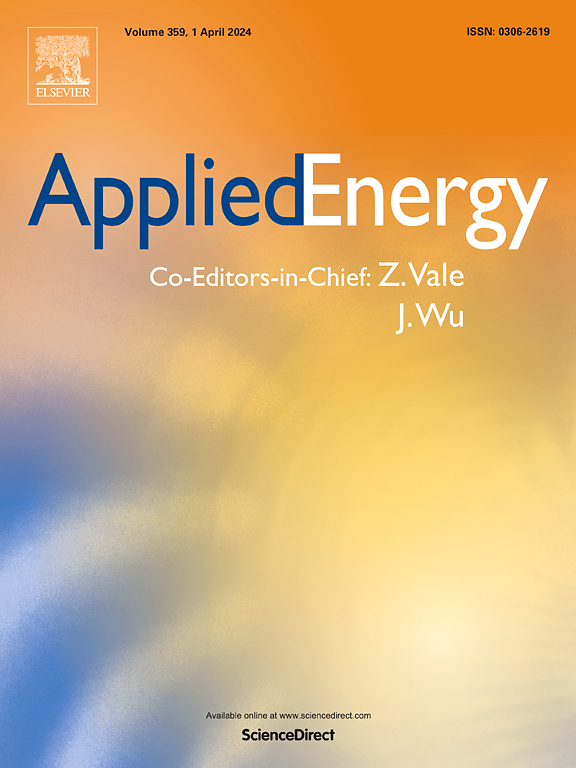基于OpenFAST线性化的动态系统导数函数代理模型(DFSM)风电机组控制协同设计
IF 11
1区 工程技术
Q1 ENERGY & FUELS
引用次数: 0
摘要
本研究提出了风力涡轮机系统的综合控制协同设计(CCD)框架,集成了通过OpenFAST线性化和数据驱动方法开发的非线性导数函数代理模型(DFSMs)。开发DFSM的主要动机是以一种计算效率高的方式准确捕获风力涡轮机系统的非线性动力学,从而在CCD框架内实现有效和可扩展的优化。开发的DFSMs成功地表示了状态导数和系统输出响应,跨越了广泛的工厂、控制和状态变量,并通过直接模拟输出进行了验证。通过同时优化电厂和控制设计,CCD方法利用了它们之间的协同作用,通过优化年能源生产(AEP)和电厂设计参数相关成本的平衡,在遵守设计和物理约束的同时,显著降低了平化能源成本(LCOE)。对比分析表明,CCD,特别是当采用开环最优控制(loc)时,优于传统的闭环控制(CLC)策略。灵敏度和稀疏度分析揭示了设计变量之间的关键相互依赖性,强调了指导目标设计优化的关键输入-输出参数关系。这些研究建立在开创性的DFSM工作的基础上,该工作仅限于少数设计和状态变量;这项工作首次将DFSM的能力提升到工程设计的实用水平。这里提出的工作是一个基础的探索;作者主张未来的研究纳入更广泛的约束和其他考虑因素,以进一步推进风力涡轮机系统优化的CCD方法。本文章由计算机程序翻译,如有差异,请以英文原文为准。
Wind turbine control co-design using dynamic system derivative function surrogate model (DFSM) based on OpenFAST linearization
This research presents a comprehensive control co-design (CCD) framework for wind turbine systems, integrating nonlinear derivative function surrogate models (DFSMs) developed through OpenFAST linearization and data-driven approaches. The primary motivation for developing the DFSM is to accurately capture the nonlinear dynamics of wind turbine systems in a computationally efficient manner, thereby enabling effective and scalable optimization within the CCD framework. The developed DFSMs successfully represent state derivatives and system output responses across extensive ranges of plant, control, and state variables, validated against direct simulation outputs. By concurrently optimizing plant and control designs, the CCD approach leverages their synergistic interactions, resulting in significant reductions in the levelized cost of energy (LCOE) through an optimized balance of annual energy production (AEP) and costs associated with plant design parameters, while adhering to design and physical constraints. Comparative analyses demonstrate that CCD, particularly when utilizing open-loop optimal control (OLOC), outperforms traditional closed-loop control (CLC) strategies. Sensitivity and sparsity analyses reveal critical interdependencies among design variables, emphasizing key input–output parameter relationships that guide targeted design optimizations. These studies build on pioneering DFSM work that was limited to a handful of design and state variables; this work advances DFSM capabilities to the level of practical utility in engineering design for the first time. The work presented here serves as a foundational exploration; authors advocate for future research to incorporate broader constraints and other considerations to further advance CCD methodologies for wind turbine system optimization.
求助全文
通过发布文献求助,成功后即可免费获取论文全文。
去求助
来源期刊

Applied Energy
工程技术-工程:化工
CiteScore
21.20
自引率
10.70%
发文量
1830
审稿时长
41 days
期刊介绍:
Applied Energy serves as a platform for sharing innovations, research, development, and demonstrations in energy conversion, conservation, and sustainable energy systems. The journal covers topics such as optimal energy resource use, environmental pollutant mitigation, and energy process analysis. It welcomes original papers, review articles, technical notes, and letters to the editor. Authors are encouraged to submit manuscripts that bridge the gap between research, development, and implementation. The journal addresses a wide spectrum of topics, including fossil and renewable energy technologies, energy economics, and environmental impacts. Applied Energy also explores modeling and forecasting, conservation strategies, and the social and economic implications of energy policies, including climate change mitigation. It is complemented by the open-access journal Advances in Applied Energy.
 求助内容:
求助内容: 应助结果提醒方式:
应助结果提醒方式:


